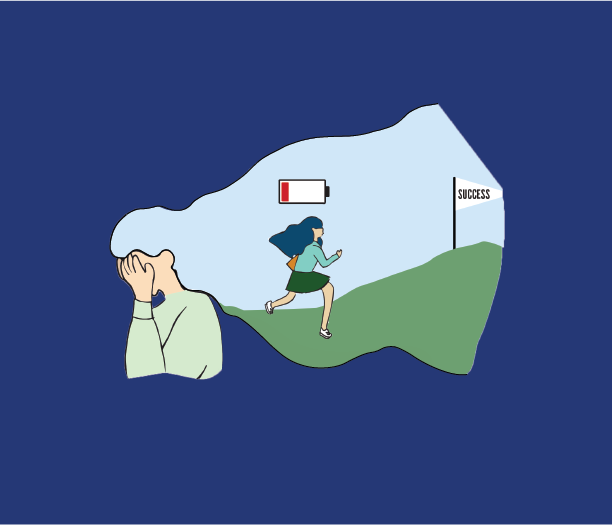After congratulating her squealing friend over their new internship, she hangs up, staring at the letter in her hand.
“Although your background and qualifications are impressive, we do not have an appropriate opportunity at this time. Thank you again for your interest, and we wish you success in your career.”
She begins to wonder why her classmate was offered the position instead of her, pondering what characteristics they had that she didn’t. Spiraling into thoughts of worthlessness, the word “disappointment” viciously replays in her pounding head as she starts to think about all the achievements that her peers have accomplished.
Whether it’s obtaining a competitive job or achieving a higher GPA, it isn’t a hidden fact that our society is driven by competition and a desire to succeed, aiming to be the best amongst a particular group of individuals.
Kaitlyn Kwan is one of the many competitive gymnasts that have experienced this competitive culture’s toxic mentality.
Kwan began her gymnastics career when she was just 4 years old at her local gymnasium. She bonded with her teammates and coaches throughout the years until the sport’s competitive aspect started to take over.
“It was enjoyable up until the part when my teammates and I started becoming really competitive, around seventh grade. It was stressful because we were competing against our own teammates to win,” Kwan said.
After living in this mindset for two years, Kwan made the ultimate decision to quit the sport she was once so passionate about. However, the transition wasn’t easy.
“After mentally deciding that I was going to quit, I had to continue going to gymnastics for a month, which made me so mentally and physically exhausted because I didn’t want to be there anymore. This made the pressure even worse than before because I felt like I was doing all this for nothing,” Kwan said.
Kwan is one of the countless students who have experienced burnout, a state of physical and mental exhaustion. According to the National Center for Biotechnology Institution, more than 31% of students experience burnout each year.
Julia Smith, a counselor at Carlmont High School, recognizes that burnout is a prevalent issue among students and acknowledges that our competitive society plays a pivotal role in engineering one to experience these symptoms.
“We live in a very competitive society. I hear students comparing their grades all the time, like, ‘Oh, well, I got an ‘A’ on this final’ and whatnot. I think that it becomes this competitive mentality in measuring how well we do,” Smith said.
Then, why do humans feel a vital need to test their mental capabilities to compete with their surroundings, and what are the effects?
When in a competitive environment, individuals perceive that their success is determined by how well they are doing compared to others around them. Because of this culture, they are pushed into a binary, black-and-white mentality, which causes one to be susceptible to emotional exhaustion.
“There are societal, family, and cultural pressures that contribute to burnout, especially in the Bay Area. Because of that, if you’re not keeping up with those indicators of success, you’re viewed as a failure. We call this black-and-white thinking, or when you believe you are either a success or a failure and there is no in-between. Of course, that’s going to lead to low self-worth, depression, and other alarming disorders,” said Nancy Liu, a professor of Clinical Psychology at the University of California Berkeley.
The toxic black-and-white thinking crept into Kwan’s experiences. Kwan said her environment pressured her to continue competitive gymnastics, despite the exhaustion she was experiencing. She acknowledges that she was willing to sacrifice her mental headspace for validation.
“The pressure to win and succeed came from me because I didn’t want to disappoint my coaches and my mom and dad. At that time, I felt that quitting meant that I didn’t live up to their expectations,” Kwan said.
Liu explains that Kwan’s mentality is a common case; many are motivated by anxiety over failure rather than striving for success. This toxic mindset ultimately led to the burnout Kwan experienced.
“We often talk about achievement as being driven to achieve something rather than driven by avoiding failure, but I think many people function to avoid failure, rather than the former. Many think ‘I don’t want not to get it because then I’m going to disappoint so-and-so’ versus the healthy mindset of ‘I really want that, and that’s something I’m going to strive towards,'” Liu said.
To combat and prevent this, Liu emphasizes the importance of deriving self-worth from something other than success. These sources of self-worth can be hobbies or gratitude for small details within one’s life.
“When we think about it clinically, we think about having all of your eggs in one basket. If anything goes wrong in that basket, and there’s nothing else to kind of fall back on, that puts a lot of stress and pressure on this one thing,” Liu said. “When we talk about healthier ways of reaching certain goals, we think about distributing the eggs into other baskets with other hobbies, other kinds of sources of value so that one’s value isn’t just based on things like achievement.”
Despite the challenges that Kwan faced when enduring the sport’s competitiveness, quitting has allowed her to reflect on her experience and mistakes. The experience has allowed her to develop the habit of “distributing her eggs,” as she now understands that one’s self-worth isn’t correlated with success.
“Gymnastics and the whole experience has taught me to apply the same mentality of worrying about yourself and do what you want to do, rather than worrying about what other people are doing and their opinion to my whole life,” Kwan said. “It is essential to prioritize what you value because there’s no point in doing things and putting all these efforts into something just to please other people.”
The fundamental steps of recognizing one’s values start to evolve at a young age when the brain is still developing, also known as the critical period of brain development. Dr. Brooke Rosen, a children’s psychiatrist at Stanford’s Lucile Packard Children’s Hospital, explains how impactful a child’s critical period is in developing these healthy habits.
“Critical periods of development are between the ages of 0 to 5, which are the most important years. Because the brain is so undeveloped, those experiences, exposure, education, and surroundings during those years really can shape their brain and mindset. It is even believed that the brain continues to develop until the age of 30,” Rosen said.
To reinforce the positive mindset of self-worth, children must receive affirmative reinforcement for their actions. Children learn from their surroundings; therefore, if a child gets positive feedback, they will be capable of replicating this mindset when encountering a problem later in life.
“The most effective ways that kids learn are through methods that are providing positive reinforcement. Kids learn much better when having rewards and praise and positive encouragement, rather than punishment and criticism,” Rosen said.
Examples of positive reinforcement may be awarding a child with a sticker after accomplishing their homework or verbally acknowledging their excellent work. These thinking methods could reduce the chances of one experiencing burnout later on in the future, especially during one’s teenage years, as peer pressure is a prominent aspect of that period.
Since the brain continues to develop well into adulthood, children and teenagers are more likely to compare themselves, as their success standards are set based on their peers’ achievements. Their impressionability causes them to be more likely to compare themselves to others, leading to burnout.
“When you think about adolescents finding their identities outside of their families, they look to their peer groups, the wider environment, and values. When they are starting to understand themselves, it’s natural to sort of chase after certain things that others in society chase after, which causes them to be easily influenced,” Liu said.
When one is trained with the concept of applying positive encouragement from a young age, it can result in resistance to peer pressure as they won’t feel a substantial need to be better than their classmates.
An example of a competitive culture being a prominent factor during adolescence and teenage years is in an academic setting.
Kwan recognizes that this toxic mindset still persists in her academic career. Instead of viewing it as a toxic trait, however, she believes that it can now drive her to a certain extent.
“I have felt this competitive culture in school, whether it is comparing test scores, extracurriculars, or classes we take with my classmates and friends. A big part of this is college applications: we are all aiming to go to a good college,” Kwan stated. “The difference between school and gymnastics is that I have learned that maintaining a balance is essential because competition is only good to a certain extent. Too much of it will consume you, resulting in an unhealthy mindset.”
Smith also acknowledges that this competitive culture is noticeable at Carlmont, as she sees it during the class selection process.
“Kids would come to me with a list of classes they were going to sign up for, and then all of a sudden that kid would come back to me with a totally different list, and I’m like, ‘where did that come from?’ They had talked to Sally, who’s taking x, y, and z, so they think they should too,” Smith said.
Smith believes that the competitive mentality can even be applied to individuals who refuse to acknowledge their exhaustion or seek help when their mental health is suffering. When discussing why this is, she believes that it comes back to our society’s competitive nature.
“When our leg is broken, we go to the doctor to fix it, and there is no shame in that. When we have scary thoughts and need help retraining our brains and redirecting those thoughts, why does it make us nervous to see psychologists or therapists when they are also doctors?” Smith said. “There is a competitive mentality that is tied to how we define our failures. People see seeking mental health resources as admitting that there is something wrong with them or that they have failed somehow. It comes down to our definition of imperfections.”
When one does experience exhaustion, Liu emphasizes that it is essential to recognize and nurture humanity’s basic mental and physical needs. By acknowledging and prioritizing one’s health, it will be easier for the individual to thrive in this competitive society.
“Getting enough sleep, food, and exercise are basics that also help you to foster a sense of resilience. This way, if disappointing news comes along, you can bounce back because you’re not so grouchy and miserable that you can say, ‘You know, that didn’t go so well I’m going to study harder next time,'” Liu said.
























Karyn Voldstad • Dec 20, 2020 at 7:41 pm
When I took a class to prepare for teaching AP Computer Science, the teacher, an older man, advised us to “make everything a competition. That will make all the students participate!” I groaned, and thought that mindset was what led to CS having such a hard time attracting diverse students. I favor an environment where students feel safe, and have done my best to provide that. I’ve even eliminated some things that were loved by some students, because I felt they led to unhealthy competition.
Important article!